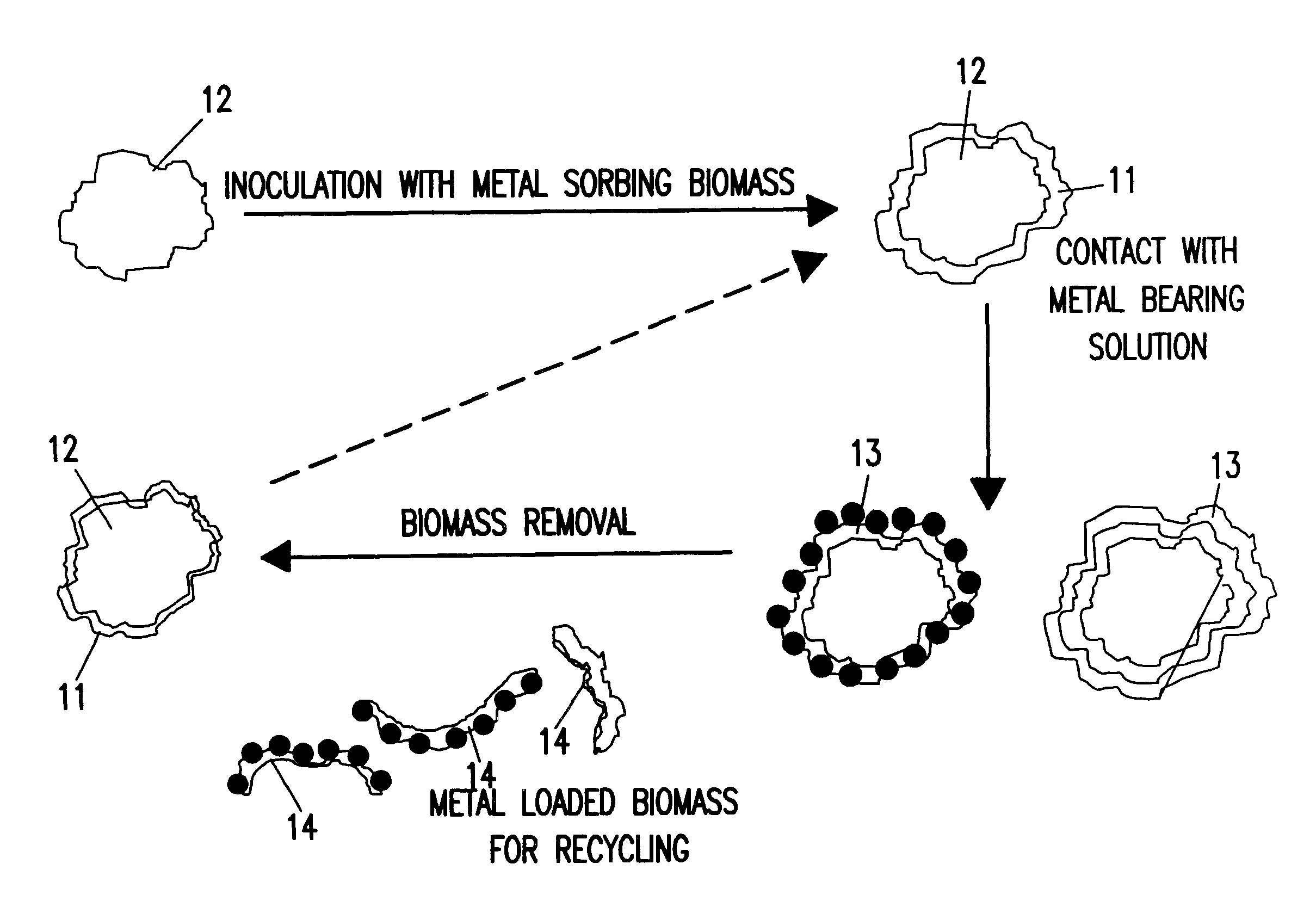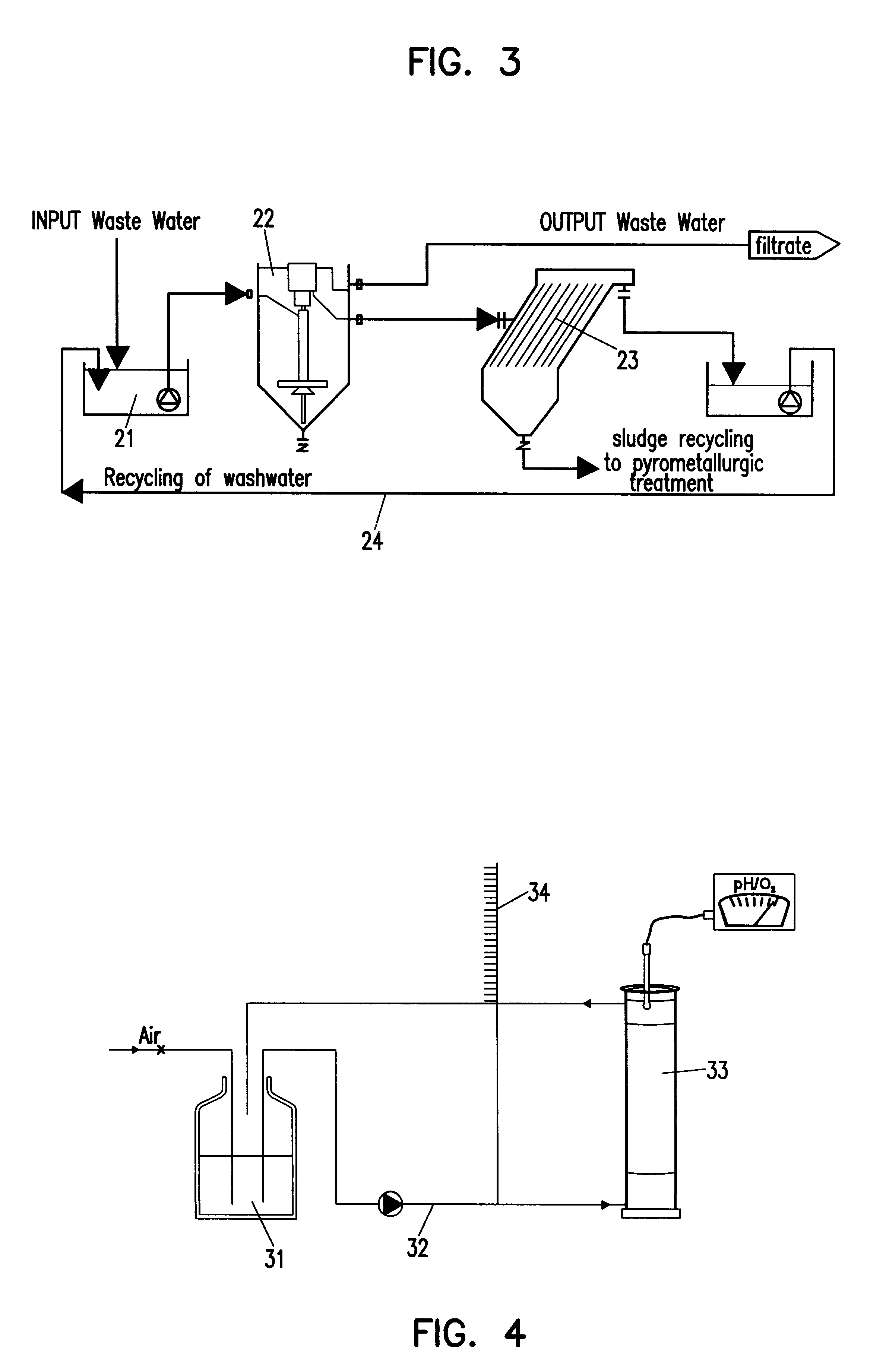Method and plant for purification of metals from water
a technology for purifying metals and water, applied in the direction of biological water/sewage treatment, sustainable biological treatment, membrane technology, etc., can solve the problems of deterioration of the reaction rate of the filter bed, inability to convert these techniques, and inability to consider the process as a fully continuous process
- Summary
- Abstract
- Description
- Claims
- Application Information
AI Technical Summary
Benefits of technology
Problems solved by technology
Method used
Image
Examples
example 2
Columns containing sand, basalt or garnet were inoculated with the mentioned strains and percolated with a solution of 12 ppm Zn. The installation is shown in FIG. 4. It comprises a reservoir 31, a peristaltic pump 32, a granular filter 33 and a piezometric tube 34. The results are presented in table 3.
From the results it could be concluded that single strain inoculation already leads to a metal reduction to below 0.1 ppm.
example 3
Inoculation of the Sand Filter
Bacteria that are able to biosorb or bioprecipitate (Alcaligenes eutrophus CH34, Alcaligenes eutrophus ER121, Pseudomonas mendocina AS302 and Arthrobacter sp. BP7 / 26) are inoculated on a moving bed granular filter with a sand medium volume of 750 1. Bacteria are cultured in a container and diluted to a concentration of about 10.sup.6 ml. This solution is used to inoculate the moving bed granular filter in batch. Afterwards, nutrients are pumped over the moving bed granular filter in a concentration of 3 mg carbon source / 1, 1 mg NH.sub.4 NO.sub.3 / 1 as nitrogen source and 0.05 mg orthophosphate / 1 of water passing the filter bed during 5 days at an inflow rate of about 10.sup.3 1 / h. During this period, the bacterial population in the filter will increase to about 10.sup.7 to 10.sup.8 cfu (colony forming units) per gram of sand.
The sand filter is now fully inoculated and ready to treat water.
example 4
Treatment of Water with an Inoculated Moving Bed Granular Filter.
An inoculated moving bed granular filter such as in example 3 is used to treat 1.5 ml.sup.3 of waste water per hour. The feed of the filter contains 5 mg carbon source / 1, 1 mg NH.sub.4 NO.sub.3 / 1 as nitrogen source and 0.05 mg orthophosphate / 1. Typically, the filter bed resistance (i.e. the increase in resistance due to the biofilm growth compared with a clean filter bed resistance) is between about 1 and 25 (H.sub.act / H.sub.0) and preferably between 1 and 5. Some process parameters are given in table 4.
The control of the growth of the bacteria in the filter is essential for an efficient and fully continuous system. A biodegradation of 10 mg COD1 leads theoretically to the formation of 4 mg biomass which counts for about 4.10.sup.6 cfu / ml. About 100 ml washwater per 1 feed is generated. The washwater contained about 100 times more biomass which corresponds to the increase of biomass due to the addition of nutrients.
T...
PUM
| Property | Measurement | Unit |
|---|---|---|
| equilibrium concentrations | aaaaa | aaaaa |
| equilibrium concentrations | aaaaa | aaaaa |
| concentrations | aaaaa | aaaaa |
Abstract
Description
Claims
Application Information
 Login to View More
Login to View More - R&D
- Intellectual Property
- Life Sciences
- Materials
- Tech Scout
- Unparalleled Data Quality
- Higher Quality Content
- 60% Fewer Hallucinations
Browse by: Latest US Patents, China's latest patents, Technical Efficacy Thesaurus, Application Domain, Technology Topic, Popular Technical Reports.
© 2025 PatSnap. All rights reserved.Legal|Privacy policy|Modern Slavery Act Transparency Statement|Sitemap|About US| Contact US: help@patsnap.com



